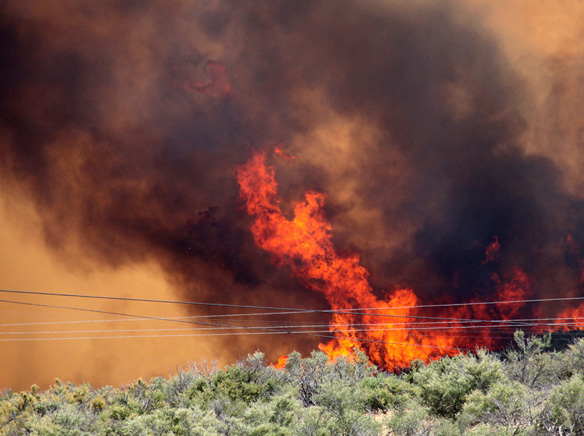On June 26, the county of San Diego held a telebriefing moderated by San Diego County Fire Authority representative Michele Clock along with Health and Human Services representative Gabe Gutierrez. Expert authorities were on hand to talk about how emergency response to wildfires might look different under social distancing due COVID-19, including evacuating with pets.
“We’re heading into the most dangerous stretch of our wildfire season, but we’re also grappling with the COVID crisis. That’s forcing fire officials to rethink the way they deal with disasters,” County Supervisor Dianne Jacob said.
San Diego County Sheriff Lt. Damon Blankenbaker has been the rural commander for all county wildfires since 1999 and said that as soon as wildfires break out, agencies typically begin working together on a unified command under the same mission: to protect property and life.
“We work to predict the size of the fire, the rate of the spread, the wind, and then we decide if we need an evacuation warning that there is a fire in the area and a probability your neighborhood will be affected, or an evacuation order. An order means you’re in immediate danger and need to evacuate as soon as possible,” Blankenbaker said.
“We need you out of the area within an hour because we fully expect the fire to take over that area.”
Department of Animal Services Animal Control Officer Supervising Lt. Denise Gove said pet owners should be able to gather their pet and items they might need in 15 minutes or less.
“You need to have a go-kit that is specific for your animal: food, medicine, documents needed and you need to make sure it is enough for 72 hours,” Gove said.
She also issued a reminder that pets can behave differently when stressed and their ability to read cues is limited by people wearing masks to halt the spread of COVID-19.
“Pets can be reactive to new gear so make sure your pet is used to seeing masks, have their own bowls and beds so no sharing, able to have social distance so they aren’t socializing with other pets. Dogs look at our face and they need to read behavior so it’s very confusing for them to have half of it covered up,” Gove said.
Additionally, she reminds residents to plan ahead.
“Have a plan for what another person can retrieve in case you’re not home when evacuation orders are given” and keep a paper copy of important phone numbers in multiple locations.”
Once people are removed from the area, the American Red Cross will step in to ensure evacuees have a safe place when they can retreat and spend the night if necessary.
“Ultimately, the local, state and federal governments have the responsibility to evacuate, care for and shelter citizens in any disaster. The Red Cross partners with those governments and when we are request¬ed we can provide care before, during and after disasters,” said Red Cross Senior Disaster program manager Dave Maloney.
In addition to what Blankenbaker terms the six ‘Ps necessary for evacuation— paper, people, prescriptions, photos, personal computers, plastic credit cards, Maloney says it is important this year to also consider extra masks, sanitizer and other supplies necessary to maintain safety under COVID-19 while evacuated.
“Evacuees needing assistance should report to Temporary Evacuation Points. Once there, Red Cross teams will arrive, assess people in the lots for water and food, pet needs, and we’ll work with partners to try and meet those needs,” Maloney said.
This year, they are working to place evacuated families with nowhere to go in hotel rooms so they remain distanced from others.
“If there is not enough room in hotels, we may be forced to go to gyms. However, there is a screening process and temperature will be tested before anyone is admitted to dormitory-style shelters. We’re increasing the square footage where people are assigned, leaving a minimum of six feet between cots, providing single-serve meals from restaurants and we’re using increased sanitization measures,” Maloney said.
Blankenbaker said residents can sign up for fire evacuation alerts at: www.readysandiego. org
Dr. Sayone Thihalolipavan also issued a reminder that free COVID testing is available throughout the county with times and locations available listed at: www.sandiegocounty. gov














